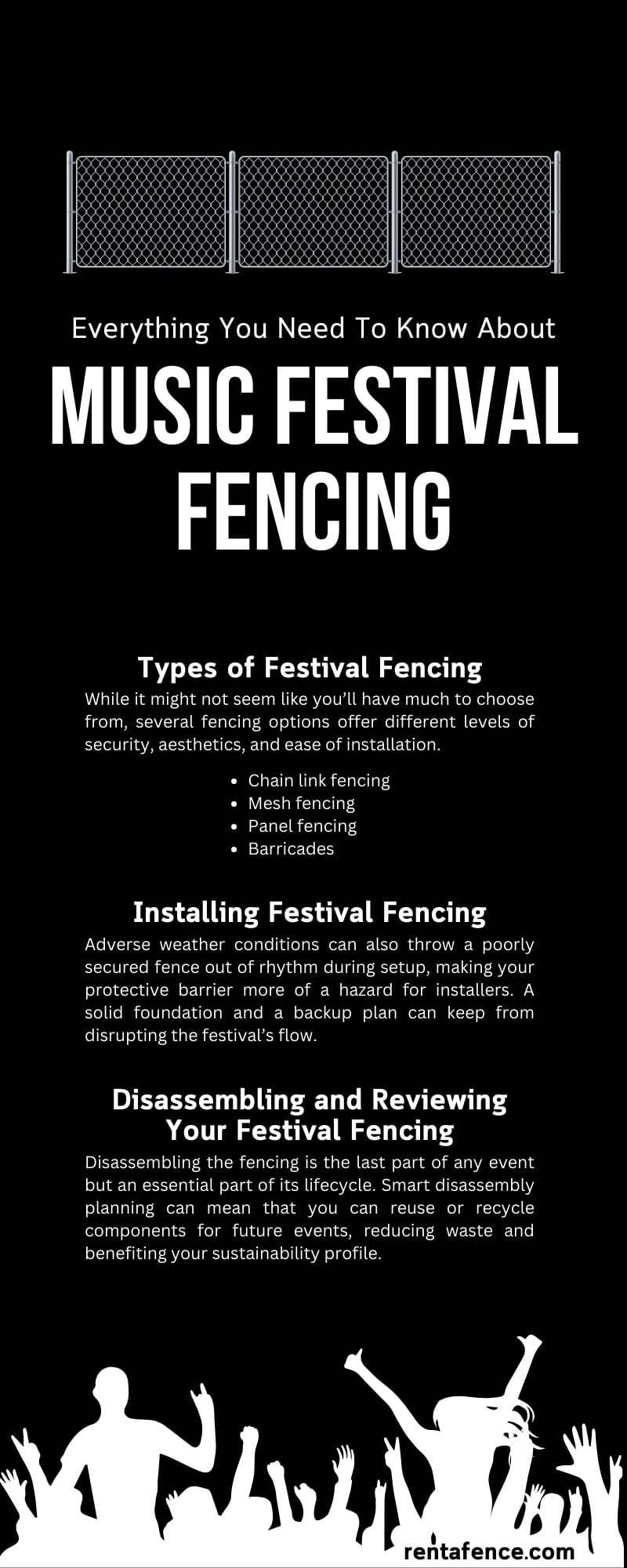For the experienced festival organizer, this guide will serve as a comprehensive reevaluation of your fencing strategies. For the budding event planner, it’s a roadmap to ensure that your festival’s fences set the tone for a safe, memorable event. Either way, the guide about music festival fencing has everything you’ll need to know before the big event.
Understanding the Basics of Festival Fencing
Festival fencing isn’t a one-size-fits-all solution. It needs to harmonize with the event’s style, security requirements, and the tastes of the crowd. But what types of fencing are in the festival lineup? How do organizers choose the right one for their particular event? It’s time to explore the options.
Types of Festival Fencing
While it might not seem like you’ll have much to choose from, several fencing options offer different levels of security, aesthetics, and ease of installation. You’ll just need to pick the best kind for your music festival.
- Chain link fencing offers security, but it’s not often the most visually appealing option.
- Mesh fencing, a more refined version of the chain link, can provide a balance of security and a clear, unobstructed view of the action.
- Panel fencing is a flexible, quick-to-install, and easily customizable temporary option.
- Barricades are the backbone of crowd control that aid in directing foot traffic and separating different zones.
Factors in Choosing Fencing
When choosing festival fencing, you must consider more than just how the fence looks. Take the time to consider the size of the event, the type of attendees, the festival grounds, and local regulations. Be sure to also consider how long the fences will be in place. Is this a large-scale, multi-day festival with varying audience sizes or a smaller, specialized event with particular crowd dynamics?
Regardless of how long the event will be, you need temporary fence options. Fortunately, we’re here to help with our diverse options in crowd control barrier rentals, so take the time to find the type that works best for your needs.
Fencing Installation and Maintenance
Picking the right type of fence is just the beginning. To set the festival stage properly, you must install fencing with precision and keep it maintained throughout the whole event.
Installing Festival Fencing
While the live performances are the draw, poorly installed fencing can quickly become the unwelcome focus. Organizers need to ensure their installation teams are well-trained and do the job efficiently.
Adverse weather conditions can also throw a poorly secured fence out of rhythm during setup, making your protective barrier more of a hazard for installers. A solid foundation and a backup plan can keep from disrupting the festival’s flow.
The Continued Maintenance
Festival fencing doesn’t end with installation; it’s an ongoing performance. Rigorous check-ups and swift responses to any damage are essential. A broken fence compromises the security of the festival, tarnishes the festival’s professionalism, and can lead to safety hazards.
Organizers must prepare for the unexpected by conducting regular walk-throughs to identify any weak spots or breaches. Also, have a team on standby to address issues as they arise during the festival.
Enhancing Safety and Crowd Control
If you want to make sure the heart-pounding bass and the shimmering lights are what festival-goers remember, you’ll need to ensure that your fences keep everyone safe.
Creating a Unified Experience Through Security
A festival’s security can’t be disjointed. Organizers must make every fencing decision in harmony with the overall security plan. All elements—fencing, personnel, and technology—work together to create an airtight operation.
Using quality fencing to control entry and exit points, section off artist and VIP areas, and create emergency access routes can improve security measures, creating a much less stressful environment for attendees and the bands who are performing.
Navigating the Crowd’s Symphony
Outside of security, another great benefit to fences at a festival is crowd management. Precisely placed barriers control the ebb and flow of festival crowds by preventing bottlenecks and providing clear pathways to patrons. With enough fencing, you can also direct attendees to areas of interest, such as stages, food vendors, performance art, and more, creating a logical and efficient flow to the event.
Branding the Beat: Incorporating Sponsorship Into Your Fencing
In the modern festival landscape, branding and sponsorship are integral to a financially successful festival. The fencing used at these events can offer a significant opportunity to weave sponsors’ messages into the very fabric of the event.
The Visuals of Sponsorship
Branded fencing can enhance the aesthetics of the festival, transforming a functional necessity into an extension of the event’s identity. Sponsors can apply their logos and marketing messages to the fencing. However, organizers must tread carefully to balance the visual aspect of sponsorship with the primary function of the fencing, ensuring that the messages won’t detract from the overall experience.
Sponsorship as a Support Act
Sponsorship doesn’t just stop at visual branding. By partnering with sponsors, festival organizers can elevate the festival by providing additional features such as Wi-Fi hotspots, charging stations, or interactive experiences. Running the cables for these attractions along the fence line is a good way to keep them off of the general walkways. Designing your layout with this in mind will create a much smoother experience.
Disassembling and Reviewing Your Festival Fencing
When the festival lights dim, it’s time for reflection, which is one of the most overlooked things you should know about music festival fencing. Disassembling the fencing is the last part of any event but an essential part of its lifecycle. Smart disassembly planning can mean that you can reuse or recycle components for future events, reducing waste and benefiting your sustainability profile.
Also, be sure to take a look at post-event reviews. These can help you understand what worked and what didn’t with your fences. Surveys and attendee feedback, combined with the observations of the festival staff, can provide invaluable insight into future events.
Be sure to reflect on the security and crowd control measures as well, and consider the visual and practical aspects of the fencing. Did it enhance the festival experience, or was it an afterthought? Your answers will set the tone for subsequent performances.


Recent Comments